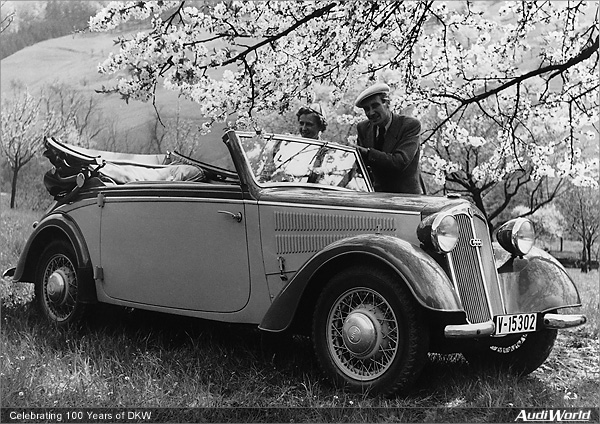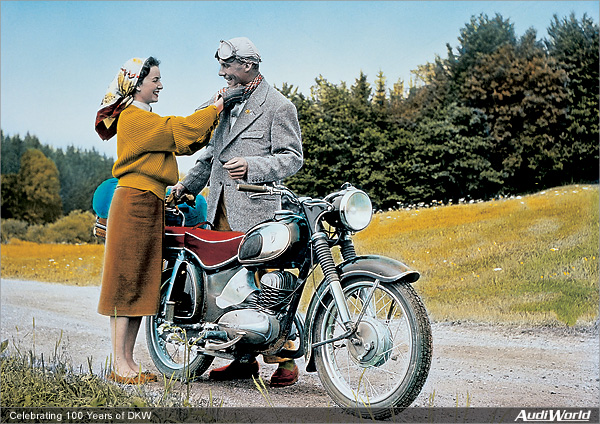Audi Tradition Celebrating 100 Years of DKW

A legend of the automotive world is celebrating its centenary this year: DKW. The company from Zschopau in Saxony originally planned to build steam-driven vehicles, yet ultimately rose to fame courtesy of its two-stroke engine. DKW had already become the worlds largest motorcycle manufacturer in the late 1920s, and then in the 1930s was the first company to mass-produce vehicles with front-wheel drive. DKW produced the pre-war periods answer to Volkswagen, the F-series small cars, in astonishing numbers. Audi Tradition is marking the anniversary of its predecessor brand by entering DKW classic cars in a whole host of events, including the Mille Miglia and the Gran Premio Nuvolari in Italy, the Concours dElegance in Bergerac, France, the Silvretta Classic and Ennstal Classic in Austria, and of course the 100 Years of Rasmussen festival in the town of Zschopau on 26 August. In 1907 the Dane Jørgen Skafte Rasmussen set up a small metal goods factory in Zschopau in the Ore Mountains. After initially manufacturing exhaust-steam oil separators, steam-engine equipment and other metal goods, he started to experiment with steam-driven cars in 1916. The project did not continue past the prototype phase. What did remain, however, was the brand name derived from this project: DKW, the abbreviation of the German word for steam-driven vehicle (Dampfkraftwagen). In 1919 Rasmussen built a two-stroke engine, which he marketed as a toy engine under the name Des Knaben Wunsch (literally: The Boys Wish). This mini-engine was enlarged and used as an auxiliary bicycle engine, and subsequently in 1922 was made into a genuine motorcycle engine known as Das Kleine Wunder (The Small Miracle). Under the auspices of Jørgen Skafte Rasmussen with Manager Carl Hahn and Chief Designer Hermann Weber, DKW developed into the worlds most important motorcycle manufacturer in the course of the 1920s in 1928 the Zschopau plant was the largest motorcycle factory in the world. In that very year Rasmussen took over the Audi car factories in Zwickau, and two years later commissioned the Audi designers with the production of a small car with the following design features: a DKW two-cylinder two-stroke motorcycle engine with a displacement of 600 cc, a unitary wooden body with leatherette upholstery, front and rear swing axles and front-wheel drive. The DKW Front was thus born, becoming one of the best-selling and most popular German small cars of its time. On 29 June 1932, Auto Union AG was founded with its headquarters in Chemnitz, a result of the Great Depression. This new enterprise was formed by the merger of the four previously independent companies Zschopauer Motorenwerke J. S. Rasmussen AG (DKW) from Zschopau, Audiwerke AG from Zwickau (which J. S. Rasmussen had already owned since 1928), Horchwerke AG from Zwickau and the automotive department of Wanderer Werke AG from Chemnitz. The DKW products were no less important for the economic development of the new company than Jørgen Skafte Rasmussen and his Zschopauer Motorenwerke enterprise had been in founding Auto Union AG. The DKW motorcycles and cars with their typical two-stroke engines served the low market segment (the price category between 345 and 3,400 Reichsmarks) and constituted the Auto Union high-volume model range. For example, up to 4,800 units of the DKW cars with front-wheel drive were built per month in the late 1930s. The DKW motorcycles were produced in such large quantities that in 1937 Auto Union once again became the worlds largest motorcycle manufacturer with its DKW plant in Zschopau, producing a total of 55,470 motorcycles. A further important area of production comprised the DKW stationary engines, which were available in an incredibly wide range of vehicles and could be used in a great variety of fields (e.g. agriculture, road construction, the fire brigade, the army and public authorities). DKW products were acknowledged to be simple, practical, reliable, economical, durable and high-performance. In terms of its technology, the Zschopau-based company proved to be an innovative pioneer in the areas of two-stroke engines, front-wheel drive and body manufacturing (wooden and plastic bodies). This pioneering spirit was also the inspiration behind the innovative potential of Auto Union AG, which set up a Central Design Office and a Central Experimental Department in Chemnitz for all Auto Union brands from 1936. A joint approach to vehicle production was cultivated at DKW to a greater extent than at any of the other Auto Union brands: the engines were manufactured at the main factory in Zschopau, the bodies were produced at the DKW body manufacturing plant in the Spandau district of Berlin; the four-cylinder models with rear-wheel drive were also built here. Assembly of the front-wheel-drive models took place at the Audi plant in Zwickau. This was a quite astonishing logistical achievement at the time. The DKW brand, whose main competitor in the 1930s was Opel, offered Auto Union great potential, with which the company fully intended to counter the expected competition from the KdF-Wagen (Volkswagen) by launching a model (DKW F 9) which was every bit its equal. This would have made Auto Union the only car company in Germany to have had an immediate response ready to challenge this Volkswagen model. After the war Auto Union GmbH, which was re-founded in West Germany, was able to re-establish a foothold in the automotive industry in Ingolstadt and Düsseldorf and it was with the DKW brand that it did so. DKW vehicles were built in West Germany until 1965, following which the two-stroke era came to an end at Auto Union in Ingolstadt and the company turned its attention to four-stroke engines, thereby enabling the renaissance of another old brand Audi. The four rings of the Audi badge symbolise the brands Audi, DKW, Horch and Wanderer, which were later combined under the umbrella of Auto Union. Auto Union and NSU, which merged in 1969, made many significant contributions towards the development of the car. AUDI AG was formed from Audi NSU Auto Union AG in 1985. Together with the two traditional companies Auto Union GmbH and NSU GmbH, Audi Tradition nurtures and presents the deep and diverse history of Audi. The Audi museum mobile at the Audi Forum Ingolstadt is open daily from Monday to Sunday, from 9 a.m. to 6 p.m.
|

